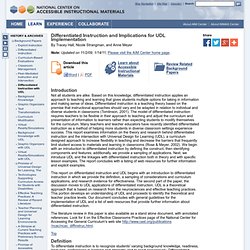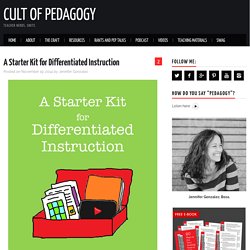Zoom
Trash

What Is Differentiated Instruction? Examples Of Strategies. Just as everyone has a unique fingerprint, each student has an individual style of learning.

Not all students in a classroom learn a subject in the same way or share the same level of ability. Differentiated instruction is a method of designing and delivering instruction to best reach each student. Carol Ann Tomlinson is a leader in the area of differentiated learning and professor of educational leadership, foundations and policy at the University of Virginia. Tomlinson describes differentiated instruction as factoring students’ individual learning styles and levels of readiness first before designing a lesson plan.
Research on the effectiveness of differentiation shows this method benefits a wide range of students, from those with learning disabilities to those who are considered high ability. Defining Differentiated Instruction. Updated 01/2014 When I lesson plan with teachers, out of earshot from their fellow teachers and their principals, I can't tell you how often I'm asked, "what exactly does it look like?

" Differentiated Instruction. Differentiated Instructional Strategies - Differentiated Strategies for Assessment. Differentiated Instruction and Implications for UDL Implementation. By Tracey Hall, Nicole Strangman, and Anne Meyer Note: Updated on 11/2/09; 1/14/11; Please visit the AIM Center home page.

Introduction Not all students are alike. Based on this knowledge, differentiated instruction applies an approach to teaching and learning that gives students multiple options for taking in information and making sense of ideas. Differentiated instruction is a teaching theory based on the premise that instructional approaches should vary and be adapted in relation to individual and diverse students in classrooms (Tomlinson, 2001). This report on differentiated instruction and UDL begins with an introduction to differentiated instruction in which we provide the definition, a sampling of considerations and curriculum applications, and research evidence for effectiveness. The literature review in this paper is also available as a stand alone document, with annotated references. Top Definition Figure 1. Identifying Components/Features Content Process Products Figure 2. Differentiated Instruction Ignites Elementary School Learning.
Teaching and Learning in the Digital Age. Learning Menus. Differentiated Instruction: Resource Roundup. Understanding Differentiated Instruction Summer DI Readings List: 150+ Seedlings for Growing Stronger Learners: Browse a bountiful reading list as you plan your garden of differentiated-instruction methods and strategies for the year. (Edutopia, 2015) Myth-Busting Differentiated Instruction: 3 Myths and 3 Truths: Get to the bottom of common misconceptions about differentiated instruction. For a quick reference on what differentiated is -- and what it isn't -- Differentiation Is / Differentiation Is Not, a set of infographics from ASCD, is also worth checking out.
(Edutopia, 2015) Defining Differentiated Instruction: Take a look at a few specific examples to better understand differentiated instruction in practice: using graphic organizers, offering alternative assignments, and providing extended work time. (Edutopia, Updated 2014) Differentiation Concept Map: Reference a flowchart that shows key elements of differentiated instruction and relationships among those elements. 6 Good Tools to Differentiate Instruction » Opening Paths. I wrote for Edutopia a six-part series that’s spanned two months.

What a great experience it’s been to share ideas. The response by readers has been amazing. As I send to Edutopia the final article in the series, I found that several of the strategies needed greater detail than I could do with the word count limit. So what follows is that deeper dive. Here’s an article that goes to the heart of student choice. See the updated version of this article. Join me through this blog on Opening Paths, especially the resources and follow me on Twitter @JMcCarthyEdS for open dialog about what our students need, and what we as professional learners can do so that ALL students succeed. 6 Good Tools to Differentiate Instruction by John McCarthy, Ed.S. The secret to Differentiated Instruction is that there is no such thing as “differentiated strategies.” So if any strategy can be differentiated based on student needs, why am I about to share an annotated list of “differentiated strategies”?
Think Dots. A Starter Kit For Differentiated Instruction. [Note: Some links below are Amazon Affiliate links.

If you click these and make a purchase, I will receive a small commission at no extra cost to you. Thanks!] You have probably come to this article for one of two reasons: Either you want to start differentiating instruction in your classroom and don’t know where to start, or you already differentiate, but want to see if you’re missing anything. 6 Strategies for Differentiated Instruction in Project-Based Learning. Project-based learning (PBL) naturally lends itself to differentiated instruction.

By design, it is student-centered, student-driven, and gives space for teachers to meet the needs of students in a variety of ways. PBL can allow for effective differentiation in assessment as well as daily management and instruction. PBL experts will tell you this, but I often hear teachers ask for real examples, specifics to help them contextualize what it "looks like" in the classroom. We all need to try out specific ideas and strategies to get our brains working in a different context. Here are some specific differentiation strategies to use during a PBL project. 1. We all know that heterogeneous grouping works, but sometimes homogenous grouping can be an effective way to differentiate in a project. 2. Reflection is an essential component of PBL. 3. This is probably one of my favorites.